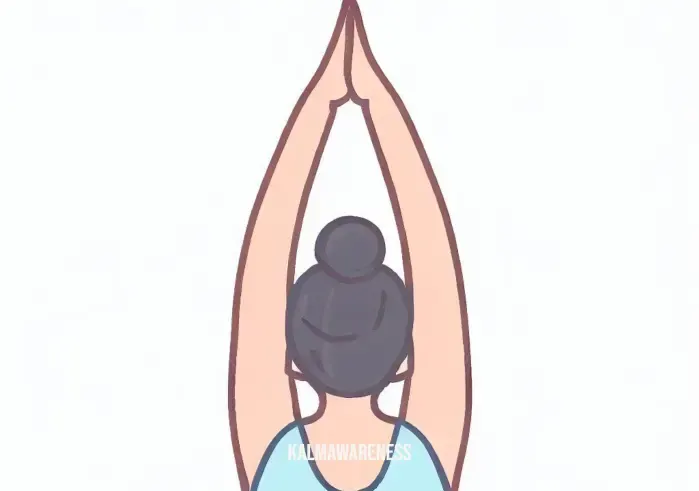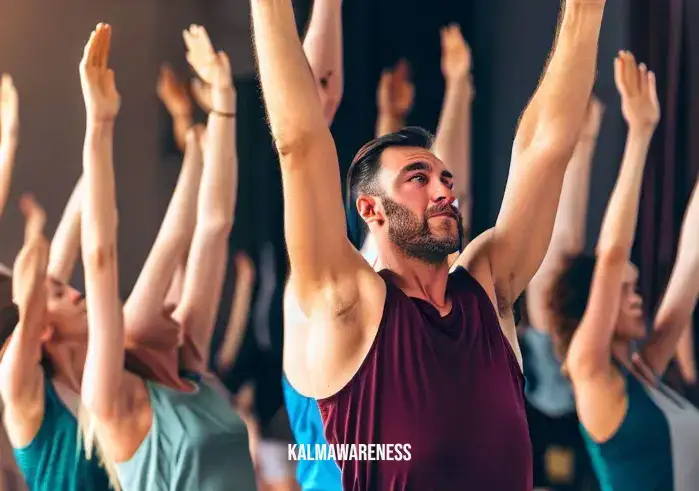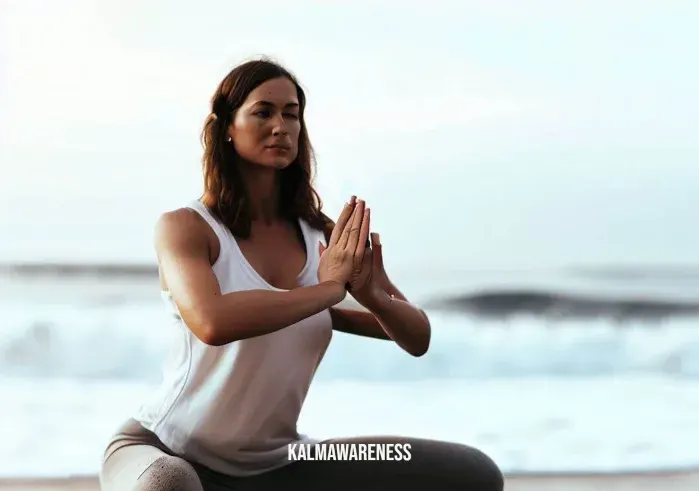Does Raising Your Arms Above Your Head Help You Breathe?
Breathing, a fundamental aspect of life, has proven to be more than a simple exchange of oxygen and carbon dioxide. From facilitating effective meditation to improving our overall wellbeing, the art of breathing goes beyond the obvious. This brings us to the intriguing question: Does raising your arms above your head help you breathe?
“Your breath is a bridge between your body and mind. When you raise your arms above your head, you’re not only exercising your muscles but also encouraging a deeper connection between your physical and mental states.”

The Science Behind Breathing
Before delving into the impact of arm positions on our breathing, let’s understand the science of breathing itself. It’s a complex interplay involving various muscles, most notably the diaphragm – a dome-shaped muscle at the base of your lungs.
As you inhale, the diaphragm contracts, creating a vacuum that draws air into the lungs. Simultaneously, the intercostal muscles between your ribs contract, expanding your chest cavity and creating even more space for your lungs to fill with air. Conversely, as you exhale, these muscles relax, allowing the lungs to spring back and push the air out.
Role of Arm Positions in Breathing
It’s quite common to notice people raising their arms above their heads during heavy exertion or while gasping for air. This instinctive action actually helps increase the volume of the chest cavity, which in turn allows for more lung expansion and a deeper intake of air.
While sitting or standing, raising your arms above your head creates a stretch in the chest wall and diaphragm. This extra space aids in more effective oxygenation of your body. If you’re someone who often experiences shortness of breath during exercise or meditation, this might be an effective strategy to explore.
Incorporating Arm Movements in Meditation
In various forms of meditation, controlled breathing techniques are often paired with specific body movements, including raising the arms. The harmony between motion and breath in these practices promotes a deeper sense of calm and focus.
Take for example the act of deep breathing with arm raises. You would start by standing tall with your arms at your sides. As you inhale deeply, you raise your arms slowly above your head. Then, as you exhale, you lower your arms back down.
Not only does this synchronize your movement with your breath, but it also allows for a fuller, deeper breath. This technique can be a beneficial part of your mindfulness routine, fostering a stronger connection between your body and mind.
We invite you to continue reading the next part of the article where we will delve deeper into the topic, exploring the relationship between breathing techniques, arm movements, and meditation practices. More insightful discussion on how raising your arms could impact your breathing during meditation and how you can incorporate this technique into your daily routine awaits you.
Understanding Body Mechanics
Understanding the mechanics of our body can often provide insights into simple actions that have significant effects, like how raising your arms can impact your breathing. During exercises or meditation practices, one may consciously or unconsciously lift their arms, contributing to a greater sense of relaxation and balance. This awareness of your bodily movements during such practices can help cultivate a deeper mindfulness experience.
Arms Above Your Head: Does it Really Help?
Indeed, it does. The question “does raising your arms above your head help you breathe” is not without scientific backing. The mechanism is rather straightforward: as you lift your arms, your ribcage expands, allowing your lungs to take in more oxygen. Simultaneously, your diaphragm is allowed more freedom to move, facilitating an even deeper breath.
“In essence, lifting your arms acts as a non-invasive ‘lung expander’, aiding in a more efficient gas exchange and improving your overall respiratory function.”
This simple act of lifting your arms can be particularly beneficial during physical exertion or when engaging in deep breathing exercises as part of your meditation routine.

From Science to Practice
Knowing the science is one thing, but integrating this knowledge into your everyday practice is another. You can begin by incorporating mindful breathing exercises into your daily routine, paying attention to the position of your arms. A great starting point could be the simple exercise of pairing deep breaths with arm raises, as discussed earlier.
But what about when you’re at your desk, or engaged in mindful hobbies? You may find it beneficial to take a few moments to stretch and lift your arms, allowing your body to take in a deep breath, and recentering your focus.
Potential Benefits and Considerations
The benefits of raising your arms above your head to breathe better extend beyond immediate improved oxygenation. This practice can potentially help manage stress and anxiety by promoting a deeper sense of calm. For individuals who frequently experience shortness of breath, whether due to a medical condition or during physical exertion, this technique could prove to be a helpful, easily accessible tool.
However, it’s worth mentioning that while this technique can help, it’s not a one-size-fits-all solution. Breathing effectively involves a combination of different factors, including posture, physical health, and even emotional state. Hence, if you’re experiencing persistent difficulties with breathing, it would be wise to consult a healthcare professional.
In conclusion, understanding our body’s mechanics and how to work with them, like learning how raising our arms above our heads aids in breathing, can significantly improve our mindfulness practices and overall quality of life. As you explore these techniques, remember to be patient and kind to yourself, taking each breath as a step towards improved wellbeing and greater mindfulness.
Stay tuned for the next part of the article where we delve further into the world of mindful breathing. Learn more about specific exercises and practices to help deepen your breathing and discover the science behind why and how these techniques work. Don’t miss out on this informative journey of breath, body, and mindfulness.
Exercises To Maximize Your Breathing
Now that we have established the answer to “does raising your arms above your head help you breathe,” let’s delve deeper into the world of mindful breathing, exploring some exercises that incorporate this method to improve your respiratory health and mental well-being.
- Standing or Seated Deep Breaths: Begin in a comfortable standing or seated position. With each inhale, raise your arms slowly above your head, and as you exhale, lower them gently back down. You should feel your chest expanding more as your arms reach upwards, allowing for deeper, fuller breaths. This simple exercise can be part of your morning meditation routine to help set the tone for the day.
- Yoga-Inspired Stretches: Incorporating yoga poses such as Mountain Pose or Upward Salute into your routine can offer similar benefits. These poses not only involve lifting your arms but also encourage total body alignment, providing you with a deeper sense of balance and calm.
- Arm Circles with Breathing: Stand with your feet shoulder-width apart. As you inhale, slowly raise your arms and move them in a circular motion, extending them overhead. Exhale as you lower them back down. This movement can also help warm-up your body before your meditation practices.
Exploring the Science Behind Breathing Exercises
While exploring these exercises, you might have noticed that each inhalation, when paired with raising your arms, allows for a deeper breath. This is due to the physiological process we mentioned earlier. But the benefits go beyond just the mechanical aspect of breathing.
The role of deep breathing in enhancing our well-being is well documented. In fact, it has been found that practicing deep breathing exercises can stimulate our body’s relaxation response, leading to decreased stress, better mood regulation, and improved sleep patterns, among other benefits.
“Understanding how raising your arms while breathing can optimize your lung capacity is an empowering tool in your arsenal of wellness practices.”
This underscores the importance of integrating mindful breathing into your daily life, whether it’s during your yoga practice, while working at your desk, or as part of your meditation routine.
Applying This Knowledge Beyond Breathing
Understanding the answer to “does raising your arms above your head help you breathe” can provide a stepping stone towards embracing a more mindful lifestyle. As you engage in these exercises, you’ll likely become more attuned to your body, noticing how certain positions affect your breath and overall comfort.
For example, you might observe that slouching at your desk constricts your breathing, causing you to take shallower breaths. Recognizing this, you can correct your posture and incorporate arm raises to take deeper breaths, thereby improving your focus and productivity.
In essence, understanding how your body functions and reacts to different stimuli, including the way you position your arms, can have a profound impact on your quality of life. This knowledge can be a foundation upon which to build a lifestyle that fosters mindfulness, tranquility, and overall well-being.
Stay tuned for the next part of this enlightening article where we’ll dive deeper into the science of breath and mindfulness. We’ll explore the direct link between good breathing habits and enhanced mental health, and how you can use these insights to create a personalized mindfulness routine that serves your unique needs. Exciting and educational discoveries await in the next chapter!

Deep Dive into the Science of Breath and Mindfulness
In our exploration of “does raising your arms above your head help you breathe,” we have uncovered that not only does this action facilitate improved oxygenation, but it can also bolster your mindfulness practice.
Mindful Breathing and Mental Health
The beauty of mindful breathing lies in its simplicity and accessibility. No matter where you are or what you’re doing, your breath is always with you, providing a constant anchor for your awareness.
An increasing body of research has identified a direct correlation between good breathing habits and enhanced mental health. Regular deep breathing exercises can alleviate symptoms of anxiety and depression, improve concentration, and increase feelings of peace and calm.
When we raise our arms and breathe deeply, we are practicing a form of mindful breathing. Mindfulness, at its core, is about bringing attention to the present moment without judgment. By focusing on the breath – observing the air as it enters and exits the body – we are grounding ourselves in the here and now.
“Breathing exercises that incorporate raising the arms can serve as a physical reminder to be fully present and to embrace each moment with acceptance and openness.”
Our mindfulness chart provides a detailed overview of how this practice can benefit various aspects of our lives.
Harnessing the Power of Breath in Your Daily Life
The next time you find yourself becoming overwhelmed or anxious, try taking a moment to focus on your breath. Better still, raise your arms overhead and take a deep breath, experiencing the amplified sensation of air filling your lungs. Notice how your body responds. Often, you will find that this simple action can break the cycle of escalating stress and restore a sense of calm.
This technique can also be useful when you find yourself struggling to focus. Our breath acts as a bridge between our body and mind. By bringing our awareness back to the breath, we can often reignite our concentration.
Creating a Personalized Mindfulness Routine
Understanding how mindful breathing can improve your mental health, you might be inspired to incorporate this practice into your daily life. Creating a personalized mindfulness routine that serves your unique needs can be a wonderful self-care activity. Here are some steps to help you establish your own routine:
- Start Small: If you’re new to mindfulness, start with just a few minutes each day. You might decide to practice deep breathing with arm raises first thing in the morning or before bed.
- Find Your Breath: Discover the rhythm and depth of breath that feels most comfortable for you. You might enjoy deep, belly breaths, or you might prefer shorter, shallower breaths. Our guide on how to find your breath can help.
- Choose a Focus: While the breath is a common anchor, you may choose to focus on something else. Perhaps the sensation of your feet on the ground, the sounds around you, or even the feeling of air on your skin.
- Create a Space: You might find it helpful to dedicate a specific space for your mindfulness practice. This could be a quiet corner of your home or a particular chair. This can help signal to your mind that it’s time to quiet down and focus.

Taking Mindful Breathing Exercises to the Next Level
Our journey into the fascinating world of breath and mindfulness continues, and now it’s time to level up. Having established that raising your arms above your head can indeed help you breathe better, we’ll now explore how to incorporate this into more complex breathing techniques and mindfulness exercises.
Mindful Movement and Breath
Mindful movement, the practice of bringing your full attention to your movements, is an excellent way to deepen your mindfulness routine. Simple actions, like raising your arms above your head, when performed mindfully, can have a profound impact on your state of being.
In our previous chapter, we discussed how this specific movement can enhance your breathing. The question now is, how can we integrate this into our everyday activities or workouts? It’s simpler than you think!
Consider your regular routine. Are there activities where raising your arms is a natural part of the process? Maybe it’s reaching for a book on a high shelf or doing some light stretching in the morning. Whatever it is, you can turn these moments into mindfulness exercises.
“The key is to slow down and bring full attention to the movement and the breath. Feel the stretch in your body as you reach upward, and observe the sensation of your lungs filling with air.”
Exploring Different Breathing Techniques
There are numerous breathing techniques that can help enhance your mindfulness practice. Some popular ones are diaphragmatic breathing, box breathing, and alternate nostril breathing.
Diaphragmatic breathing involves breathing deeply into your lungs by flexing your diaphragm, rather than shallow breathing in your chest. This can be enhanced by raising your arms as you breathe in, promoting a deeper intake of air. Box breathing is a technique used to calm yourself down and involves taking slow, deep breaths while counting to four. Alternate nostril breathing is a technique that originates from yoga and involves alternating breathing through different nostrils.
Learning to master these techniques takes practice, but the rewards are significant. These methods can increase your lung capacity, decrease stress, and improve mental clarity. Our detailed article on gentle air movements will provide you with more information about these techniques.
The Role of Breath in Meditation
If you’ve ever dabbled in meditation, you’ve likely come across breathing exercises. Breathwork forms the foundation of many meditation practices, providing an anchor for your attention as you cultivate mindfulness.
When you raise your arms and breathe deeply during meditation, you are expanding your diaphragm and creating space for your lungs to fill with air. This enhances your ability to stay present, keeping you grounded and focused during your practice. For more guidance on how to incorporate breathwork into your meditation routine, visit our page on keeping meditation simple.
Conclusion
So, does raising your arms above your head help you breathe? Yes, indeed it does. Not only does it optimize our physiological function, but it also serves as a tool for enhancing our mindfulness practice.
Join us in the next part of this comprehensive article as we explore the world of mindful movement and delve deeper into various breathing techniques. The upcoming section will guide you on how to take mindful breathing exercises to the next level, explore the link between movement and breath, and provide insights on how to adapt these exercises to suit your unique needs and preferences.
We’ve unraveled the science behind why raising your arms above your head helps you breathe better and explored various ways to integrate this knowledge into our daily lives. With these techniques, we’re not just enhancing our physical health; we’re also improving our mental well-being by cultivating mindfulness.
Continue to the final part of this series, where we will delve into the concept of ‘breathing spaces’ and discuss how these can transform your mindfulness practice. We will also explore how mindfulness can be incorporated into different aspects of your life, from your hobbies to your relationships. Stay tuned!




